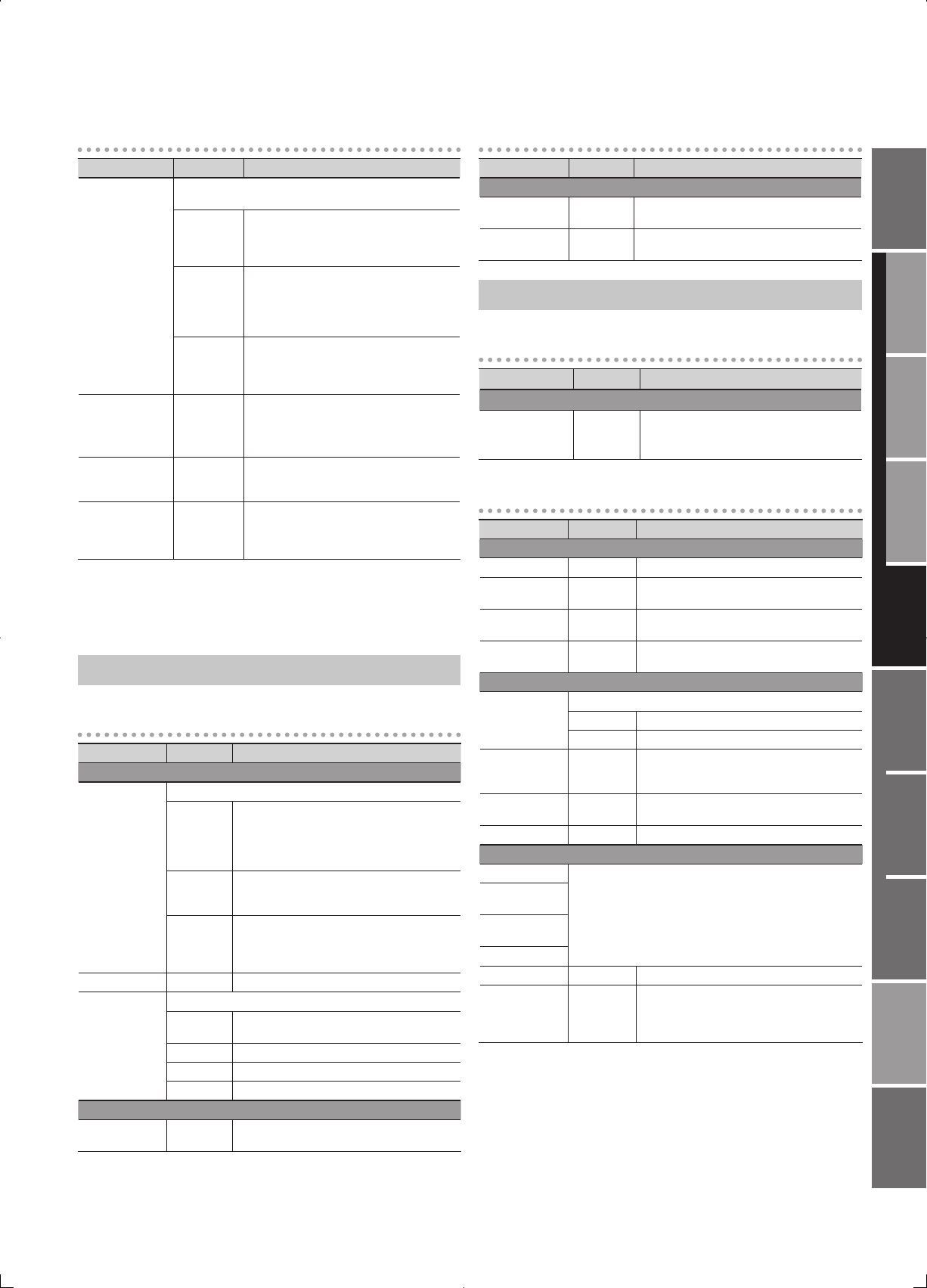
83
Overview
Appendix
USB Memory
Song Player
Digital Recorder
Synthesizer
Selecting Sounds Perform. Functions Editing/Eects Other Settings
Rec/Play/Edit Eects Rhythm Pattern
[4] (SYNC)
Parameter Value Explanation
USB Song Sync
Mode
Species the synchronization signals that the JUNO-Gi’s USB
memory song player will follow.
MASTER
The JUNO-Gi’s USB memory song player will
be the master. Choose this setting if you’re
operating the JUNO-Gi by itself, without
synchronizing it to any other device.
SLAVE
The JUNO-Gi’s USB memory song player will
be the slave. Choose this setting if you want
the JUNO-Gi to operate according to MIDI
Clock messages received from an external
device.
REMOTE
The JUNO-Gi’s USB memory song player will
obey MIDI Start, Continue, and Stop messages
from an external device, but will use its own
keyboard tempo.
MIDI Clock
Output
OFF, ON
If this is ON, the JUNO-Gi will transmit MIDI
clock to an external MIDI device.
* This cannot be set if USB Song Sync Mode
is “SLAVE.”
LiveSet Tempo
Switch
OFF, ON
If this is ON, switching live sets will make
the keyboard tempo change to the “LiveSet
Tempo” (p. 38) specied for that live set.
Tempo Link OFF, ON
If this is ON, the keyboard tempo will match
the recorder tempo. This is convenient when
you want to play arpeggios in time with the
tempo of the recorder’s song (p. 32).
* The JUNO-Gi’s Digital Recorder cannot synchronize to an external
MIDI device.
* If the Tempo Link is on, the JUNO-Gi cannot synchronize to an
external MIDI device (p. 134).
System Menu [4] (CLICK/PLAYER)
[1] (CLICKOUT)
Parameter Value Explanation
Click Setting
Song/Click
Output from the SONG/CLICK OUT jack
CLICK
When the USB Memory Song Player is playing
back, a click tone at the tempo of the USB
memory song will be output from the SONG/
CLICK OUT jack (it will not be output from the
OUTPUT L/R jacks.)
RECORDER
The sound from the Digital Recorder will be
output from the SONG/CLICK OUT jack (it will not
be output from the OUTPUT L/R jacks).
USB SONG
The sound from the USB Song Player and USB
audio of your computer will be output from the
SONG/CLICK OUT jack (it will not be output from
the OUTPUT L/R jacks).
Click Level 0–10 Volume of the click
Click Sound
Sound type of the click
TYPE 1
A conventional click sound (A bell will sound on
the rst beat.)
TYPE 2 Clicks
TYPE 3 Beeps
TYPE 4 Cowbell
Level
Song/Click
Output Level
0–127
Volume of the output from the SONG/CLICK
OUT jack
[2] (PLAYER)
Parameter Value Explanation
Song Player Level
Audio Level 0–127
Sets the volume at which audio les will be
played by the USB memory song player.
SMF Level 0–127
Sets the volume at which SMF will be played by
the USB memory song player.
System Menu [5] (D BEAM)
[1] (GENERL)
Parameter Value Explanation
Sensitivity
D Beam Sens 0–127
This sets the D Beam controller’s sensitivity.
Increasing this value will make the D Beam
controller more responsive.
[2] (SYNTH)
Parameter Value Explanation
Level & Range
Level 0–127 Volume Level of the Solo Synth
Chorus Send
Level
0–127 Level of the signal sent to chorus
Reverb Send
Level
0–127 Level of the signal sent to reverb
Range
2OCT, 4OCT,
8OCT
Range in which the pitch of the solo synth will
vary
Osc1
Osc 1 Waveform
Waveform
SAW Sawtooth wave
SQR Square wave
Osc 1 Pulse
Width
0–127
Pulse width of the waveform
By cyclically modifying the pulse width you can
create subtle changes in the tone.
Osc 1 Coarse
Tune
-48–+48
Pitch of the tone’s sound (in semitones, +/-4
octaves)
Osc 1 Fine Tune -50–+50 Pitch of the tone’s sound (in 1-cent steps)
Osc2 & Sync
Osc 2 Waveform
(same as Osc 1)
Osc 2 Pulse
Width
Osc 2 Coarse
Tune
Osc 2 Fine Tune
Osc 2 Level 0–127 Level of the OSC2
Osc Sync Switch OFF, ON
Turning this switch on produces a complex
sound with many harmonics. This is eective
when the OSC1 pitch is higher than the OSC2
pitch.


















